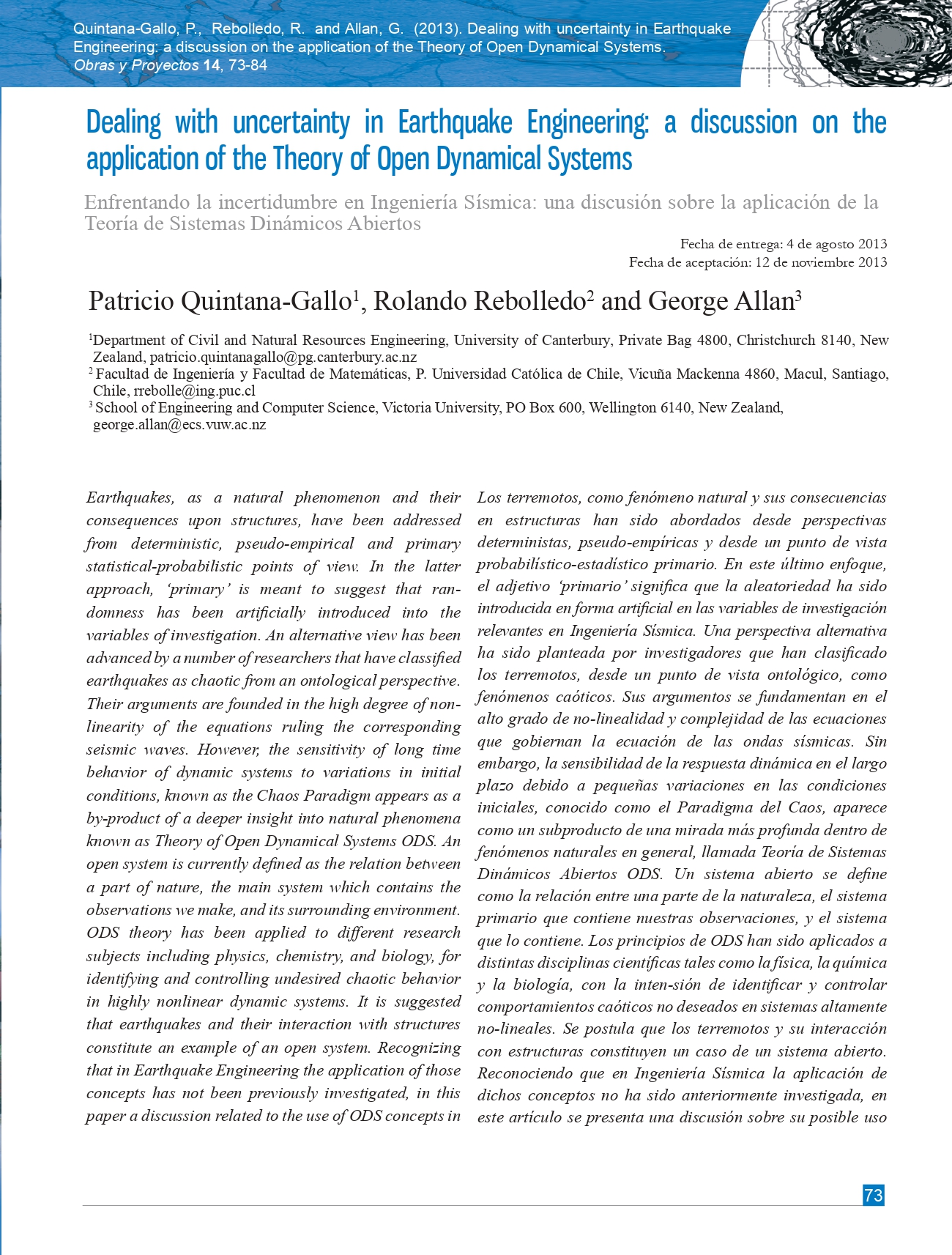Dealing with uncertainty in Earthquake Engineering: a discussion on the application of the Theory of Open Dynamical Systems
DOI:
https://doi.org/10.4067/S0718-28132013000200006Keywords:
structural dynamics, seismic uncertainty, chaos, open dynamical systems, seismic interactionAbstract
Earthquakes, as a natural phenomenon and their consequences upon structures, have been addressed from deterministic, pseudo-empirical and primary statistical-probabilistic points of view. In the latter approach, 'primary' is meant to suggest that randomness has been artificially introduced into the variables of investigation. An alternative view has been advanced by a number ofresearchers that have classified earthquakes as chaotic from an ontological perspective. Their arguments are founded in the high degree of non-linearity of the equations ruling the corresponding seismic waves. However, the sensitivity of long time behavior of dynamic systems to variations in initial conditions, known as the Chaos Paradigm appears as a by-product of a deeper insight into natural phenomena known as Theory of Open Dynamical Systems ODS. An open system is currently defined as the relation between a part of nature, the main system which contains the observations we make, and its surrounding environment. ODS theory has been applied to different research subjects including physics, chemistry, and biology, for identifying and controlling undesired chaotic behavior in highly nonlinear dynamic systems. It is suggested that earthquakes and their interaction with structures constitute an example of an open system. Recognizing that in Earthquake Engineering the application of those concepts has not been previously investigated, in this paper a discussion related to the use of ODS concepts in that particular field is presented. Using the most basic case of a linear elastic single degree offreedom SDOF oscillator, differences in the prediction of the response of the system subjected to only one ground motion using a Newton classical approach and ODS concepts, which involve stochastic processes, are compared. Conclusions about the consequences of the application of ODS theory for re-understanding Earthquake Engineering are presented, and a general critique to primary probabilistic approaches for addressing the same problem is formulated.
References
Anagnos, T. and Kiremidjan, A. (1988). A review of earthquake occurrence models for seismic hazard analysis. Probabilistic Engineering Mechanics 3(1): 3-11. https://doi.org/10.1016/0266-8920(88)90002-1
Applebaum, D. (2004). Lévy Processes-From Probability to Finance and Quantum Groups, Notices of the AMS 52: 1336-1347
Applebaum, D. (2009). Lévy processes and stochastic calculus. Cambridge Studies in Advanced Mathematics, Vol. 116.
Baker, J.W. and Cornell, C. A. (2006). Spectral shape, epsilon and record selection. Earthquake Engineering and Structural Dynamics 35: 1077-1095. https://doi.org/10.1002/eqe.571
Baker, J.W. and Cornell, C. A. (2008). Uncertainty propagation in probabilistic seismic loss estimation. Structural Safety 30: 236-254. https://doi.org/10.1016/j.strusafe.2006.11.003
Biot, M.A. (1943). Analytical and experimental methods in engineering seismology. Transactions of the American Society of Civil Engineers 108(1), 365-385. https://doi.org/10.1061/TACEAT.0005571
Bolotin, V.V. (1960). Statistical theory of the aseismic design of structures. Proceedings of the Second WCEE, Tokyo, Japan, 1365-1373
Chopra, A. K. (2001). Dynamics of structures. Theory and application to Earthquake Engineering. Prentice Hall, New Jersey
Ditlevsen, O. and Bognár, L. (1993). Plastic displacement distributions of the Gaussian white noise excited elasto-plastic oscillator. Probability Engineering Mechanics 9: 209-231
Fagnola, F., Rebolledo, R., and Saavedra, C. (1994). Quantum flows associated to master equations in quantum optics. Journal of Mathematical Physics 35(1):1-12. https://doi.org/10.1063/1.530788
Gamble, J. A., Wood, C. P., Price, R. C., Smith, I. E. M., Stewart, R. B., Waight, T. (1999). A fifty year perspective of magmatic evolution on Ruapehu Volcano, New Zealand: verification of open system behaviour in an arc volcano. Earth and Planetary Science Letters 170: 301-314. https://doi.org/10.1016/S0012-821X(99)00106-5
Goodman, L.E., Rosenblueth, E. and Newmark, N.M. (1954). Aseismic design of elastic structures founded on firm ground. Proceedings of the ASCE Structural Division, Vol. 79, separate n. 239
Housner, G.W., Martel, R.R., and Alfred, J.L. (1953). Spectrum analysis of strong-motion earthquakes. Bulletin of the Seismological Society of America 43(2), 97-119
Housner, G.W. (1947). Characteristics of strong-motion earthquakes. Bulletin of the Seismological Society of America 37(2): 19-31
Kloeden, E. and Platen, E. (1992). Numerical Solution of Stochastic Differential Equations. Springer-Verlag, Berlin. https://doi.org/10.1007/978-3-662-12616-5
Kossakowski, A. and Rebolledo, R. (2007). On non-Markovian time evolution in open quantum systems. Open Systems & Information Dynamics 14(3), 265-274. https://doi.org/10.1007/s11080-007-9051-5
Lorenz, E. (1963). Deterministic Non Periodic Flow. MIT Press, Massachusetts, USA
Mackie, K. and Stojadinovic, B. (2004). Improving probabilistic seismic demand models through refined intensity measures. Proceedings of the 13th WCEE, Vancouver, Canada.
Platen, E., and Rebolledo R. (1985). Weak convergence of semimartingales and discretization methods. Stochastic Processes and their Applications 20: 41-58. https://doi.org/10.1016/0304-4149(85)90016-X
Popper, K. (1963). Conjectures and Refutations. Rouledge, New York, USA
Priestley, M.J.N. (1998). Displacement-based approaches to Rational Limit States Design of New Structures. European Conference on Earthquake Engineering. Paris, France.
Priestley, M.J.N. (2003). Myths and Fallacies in Earthquake Engineering. IUSS Press, Pavia, Italy
Priestley, M.J.N., Calvi, G.M. and Kowalsky, M. (2007). Displacement-based seismic design of structures. IUSS Press, Pavia, Italy
Quintana-Gallo, P. (2008). Analytical evaluation of damage in an RC building with T-shaped walls. MSc thesis Universidad Técnica Federico Santa María, Valparaíso, Chile
Quintana-Gallo, P., Akguzel, U., Pampanin, S. and Carr, A.J. (2011). Shake table tests of non-ductile as-built and repaired RC frames. Proceedings of the Pacific Conference on Earthquake Engineering, Auckland, New Zealand, paper 201
Quintana-Gallo, P., Bonelli, P., Restrepo, J., Pampanin, P. and Carr, A.J. (2013)a. Seismic assessment of RC walls after the 27 February 2010 Maule Chile earthquake. Submitted to Journal of Earthquake Engineering.
Quintana-Gallo, P., Pampanin, P., Carr, A.J., Restrepo, J., and Bonelli, P. (2013)b. Seismic assessment of RC walls after the 22 February 2011 Canterbury New Zealand earthquake. under submission process for the Journal of Earthquake Engineering (companion paper).
Rey-Bellet, L. (2006). Open Classical Sytems. In Open Quantum Systems II, The Markovian approach, 41-77, Springer, Berlin. https://doi.org/10.1007/3-540-33966-3_2
Rebolledo, R. (2004). Open quantum systems and classical trajectories. In Stochastic Analysis and Mathematical Physics (SAMP/ANESTOC 2002), 141-164. World Sci. Publishing, River Edge, NJ.
Rebolledo, R. (1979). La méthode des martingales appliquée à l'étude de la convergence en loi de processus. Mémoires de la Société Mathematique de France 62, i-v, 1-125
Rebolledo R. (1980). Central limit theorems for local martingales. Zeitschrift für Wahrscheinlichkeitstheorie und Verwandte Gebiete 51: 269-286. https://doi.org/10.1007/BF00587353
SEAOC (1995). Performance based seismic engineering of buildings. Vision 2000 Committee. Structural Engineers Association of California, Sacramento, CA.
Standards New Zealand (2002). NZS1170.1 - Structural design actions: Part 1, General Principles. Wellington, NZ.
Standards New Zealand (2004). NZS1170.5 - Structural design action: Part 5, Earthquake Actions. Wellington, NZ.
Strogatz, S. (1994). Nonlinear Dynamics and Chaos. Westview Press, Cambridge MA, USA
Suzuki, Y., and Minai, R. (1988). Application of stochastic differential equations to seismic reliability analysis of hysteretic structures. Probabilistic Engineering Mechanics 3, n.1, 43-52. 10.1016/0266-8920(88)90007-0
Uma, S.R., Pampanin, S. and Christopoulos, C. (2010). Development of a probabilistic framework for performance-based seismic assessment of structures considering residual deformations. Journal of Earthquake Engineering 14(7): 1092-1111. https://doi.org/10.1080/13632460903556509
von Bertalanffy, L. (1950)a. An Outline of General System Theory. British Journal of the Philosophy of Science 1: 134-164. https://doi.org/10.1093/bjps/I.2.134
von Bertalanffy, L. (1950)b. The Theory of Open Systems in Physics and Biology. Science 111: 23-29

Downloads
Published
Issue
Section
License
Copyright (c) 2013 Universidad Católica de la Santísima Concepción

This work is licensed under a Creative Commons Attribution-NonCommercial 4.0 International License.







